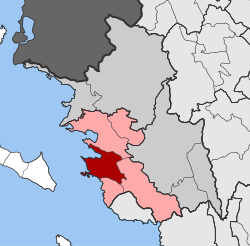Syvota
Syvota (Greek: Σύβοτα, pronounced [ˈsivota], before 1940: Μούρτος Mourtos[2] pronounced [ˈmurtos]) is a village and a former municipality in Thesprotia, Epirus, Greece. Since the 2011 local government reform it is part of the municipality Igoumenitsa, of which it is a municipal unit.[3] The municipal unit has an area of 72.439 km2.[4] The population in 2011 was 875 for the village, and 2,640 for the municipal unit. The seat of the municipality was in Plataria.
Syvota Σύβοτα | |
|---|---|
View of Syvota. | |
 Syvota Location within the regional unit  | |
| Coordinates: 39°24′N 20°15′E | |
| Country | Greece |
| Administrative region | Epirus |
| Regional unit | Thesprotia |
| Municipality | Igoumenitsa |
| • Municipal unit | 72.4 km2 (28.0 sq mi) |
| Population (2011)[1] | |
| • Municipal unit | 2,640 |
| • Municipal unit density | 36/km2 (94/sq mi) |
| Community | |
| • Population | 875 (2011) |
| Time zone | UTC+2 (EET) |
| • Summer (DST) | UTC+3 (EEST) |
| Vehicle registration | ΗΝ |
History
The earliest recorded inhabitants of the region are the Thesprotians, a Greek tribe of Epirus. In antiquity, the location was called Sybota and was the site of the Battle of Sybota.
During the Middle Ages, Syvota, like the rest of Epirus, was part of the Byzantine Empire and the Despotate of Epirus. Under the Turks, it was called Mourtos.
After nearly 500 years of Ottoman rule, Syvota joined Greece in 1913, following the Balkan Wars. The coastal village of Syvota (Albanian: Murto or Vola) was home to Cham Albanians before 1944, when they were expelled for collaborating with the Axis Powers.[5]
Today, Syvota town is a well-developed resort, owing largely to the numerous pristine beaches with clear waters located on several islets immediately offshore.
Population
The population of Syvota is 875 (as of 2011).
| Year | 1895 | 1913 | 1928 | 1940 | 1951 | 1961 | 1971 | 1981 | 1991 | 2001 | 2011 |
|---|---|---|---|---|---|---|---|---|---|---|---|
| Population | 1066[6] | 970[7] | 679[8] | 883[9] | 241[8] | 684[8] | 560[8] | 575[8] | 756 [10] | ; | 875[1] |
References
| Wikivoyage has a travel guide for Syvota. |
- "Απογραφή Πληθυσμού - Κατοικιών 2011. ΜΟΝΙΜΟΣ Πληθυσμός" (in Greek). Hellenic Statistical Authority.
- Name changes of settlements in Greece
- Kallikratis law Greece Ministry of Interior (in Greek)
- "Population & housing census 2001 (incl. area and average elevation)" (PDF) (in Greek). National Statistical Service of Greece.
- Vickers, Miranda and Pettifer, James. The Albanian Question: Reshaping the Balkans. I.B. Tauris, 2007, ISBN 1-86064-974-2, p. 238.
- Μιχάλης Κοκολάκης, Η τουρκική στατιστική της Ηπείρου στο Σαλναμέ του 1895, στο Τετράδια Εργασίας, τεύχος 18, Κέντρο Νεοελληνικών Ερευνών, Αθήνα 2008, σελ 310.
- "Βασίλειον της Ελλάδος, Υπουργείον Εθνικής Οικονομίας, Διεύθυνσις Στατιστικής, Απαρίθμησις των κατοίκων των νέων επαρχιών της Ελλάδος" (PDF). dlib.statistics.gr. 1913. p. 69. Retrieved 2 August 2015. (in Greek)
- Μιχαήλ Σταματελάτος - Φωτεινή Βάμβα-Σταματελάτου, Επίτομο Γεωγραφικό Λεξικό της Ελλάδος, Ερμής, Αθήνα 2001, σ. 724.
- Kingdom of Greece - Ministry of National Economy - Hellenic Statistical Authority (1950). Πληθυσμός της Ελλάδος κατά την απογραφήν της 16 Οκτωβρίου 1940 (PDF) (in Greek). Athens: National Printing Office. p. 155.
- Στατιστικά στοιχεία δ. Συβότων (in Greek)